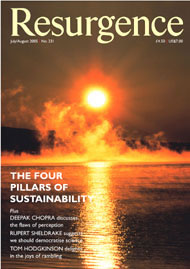AS WE WAKE up to global warming, attention is at last being focused on its major causes: transport, industry and buildings. For the UK government to achieve its 20% reduction in CO2 emissions by 2010, industry, transport, building and domestic energy use all need to be placed under the microscope. In particular, the construction industry accounts for over 50% of the UK's energy use, and therefore, is a major contributor to the production of greenhouse gasses.
There are two ways in which buildings use energy. One is embodied energy and the other is operational energy. Embodied energy covers all the energy expended in constructing the building, including quarrying, transporting and processing the raw materials and the activity of construction itself. Not only the main building medium of bricks or concrete, but plastics, PVC and steel all contribute to the embodied energy. However, this can pale into insignificance when compared with the ongoing energy use calculated over the lifetime of the building: the operational energy. In a domestic building this includes heating, lighting, cooking, power-tools, TVs, stereos and computers.
In recent years new regulations, pioneering work by the Building Research Establishment and, the development of a national Code for Sustainable Building Practice (CSBP) have raised awareness of the need to conserve operational energy in building. Although the CSBP is to be a voluntary code of practice, it is hoped that builders will be swift to comply with it as it will be considered a desirable mark of quality and sustainability. With 200,000 additional homes planned for the South East, implementation of this code cannot come a moment too soon.
Conserving energy use in buildings can be achieved through the use of more efficient insulation and power generation. But, of course, more insulation can itself increase the embodied energy, because some forms of insulation expend large amounts of energy during the manufacturing process - though the development of more natural insulation materials such as sheep's wool and recycled paper should, in time, ameliorate this. Victoria University in New Zealand has calculated the embodied energy of various insulation materials so that comparisons can be made, and these figures show that while fibreglass uses 269kWh/m3, and polystyrene 650kWh/m3 to produce, sheep's wool takes only 39kWh/m3.
It is clearly important to consider the energy use of a building as a whole, including both its construction and its sustainability in the longer term, but this can lead to unexpected consequences. For example, a Devon barn conversion might have extremely low embodied energy because either the building is already standing or the materials are all on site and reusable; but this low embodied energy will have little merit if the insulation is insufficient to ensure low operational energy. Conversions have to adhere to the same rules as new buildings, so levels of insulation and glazing are pre-determined. However, the barn walls, which can be as much as a metre thick, constitute a high thermal mass, which takes a long time to warm up but retains heat for far longer than an equivalent brick wall. This is ideal for a home in permanent use, as the walls, once warm, retain their heat. Increasing the internal insulation, however, can turn the walls into a low thermal mass, in which case the thick stone will not contribute to the insulation. The only way to preserve the advantages of the thick walls would be to insulate them on the outside; but to do this would lose the appearance of the original stone barn, which was the reason the developer or purchaser wanted to convert the building in the first place.
Another conundrum arises with regard to old Victorian housing stock. Solid brick walls are poor insulators, and although it is possible to use thermal wallpapers on the inside or to add a layer of masonry insulation to the outside, in general these buildings will remain wasteful of energy. A badly insulated Victorian house requires about five times as much energy to heat as a new house; and building regulations have forced up the insulation of new buildings so much, even in recent years, that while a house built in 1975 might have an annual space heating demand of 36,400kWh, this reduces to 7,100kWh for a house built in 2002. As building regulations become stricter, so the energy efficiency of homes will increase further, raising the question as to whether it is better to pull down and re-build our inefficient older housing stock, rather than attempting to retrofit better energy-efficient measures.
With new houses it is easier to balance the relative merits of saving on embodied energy and keeping operational energy to a minimum without incurring massive additional building costs. The Low-Energy House built in 1976 at the Centre for Alternative Technology at Machynlleth, Wales, for instance, has 450mm of rock wool insulation in roof, floor and walls, and quadruple-glazed windows. It takes only just over 1kW to keep warm - about a fifth of that used in a conventional house. With such low energy use, the extra embodied energy was cancelled out in a very short time, and the additional building cost was only about 10%.
As we move towards more energy-efficient dwellings, limiting the embodied energy once more becomes the major concern. Recently, there have been experiments and developments both in lowering the embodied energy of new buildings and in minimising operational energy. Materials such as cob, straw bale, green oak and hemp can contribute to reducing both types of energy use; earth structures have opened up a whole new realm of sustainable design; clay and lime are increasingly used inside homes; earthship constructions have been built from used tyres (of which the UK generates 40 million a year); and an understanding of passive solar gain has changed the way architects and developers design buildings.
There have also been some exciting new buildings which aim to be carbon neutral, such as Zero Energy Developments. Some of our most famous architects are now incorporating significant environmental aspects into their designs, the best-known example probably being Bill Dunster's BedZed development in Sutton, near London. Some of Dunster's other designs have been rejected by planning authorities; innovative design, even when it contributes to lower CO2 emissions, will not always be popular with neighbours, conservationists or councils.
The positive side of the huge contribution the building trade makes to our CO2 emissions is that by systematically cutting both embodied and operational energy use, the industry will be in a prime position to help us achieve our targets and move beyond them to a more sustainable future. o
Try out the Resurgence [article id="index.htm" title="House Energy Audit Calculator"]








